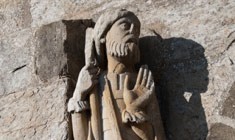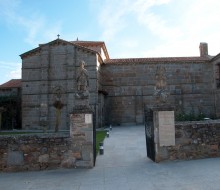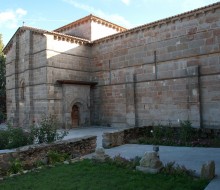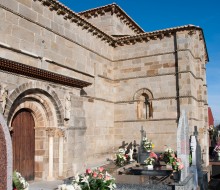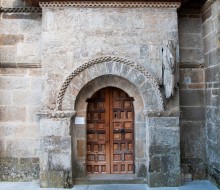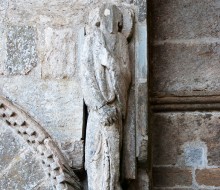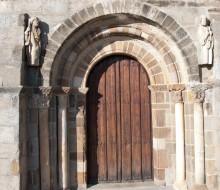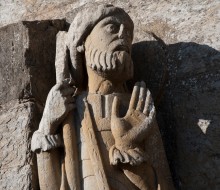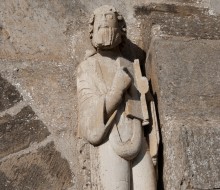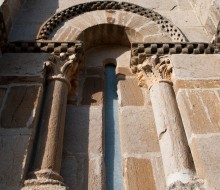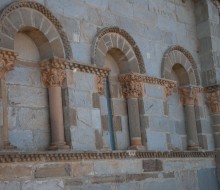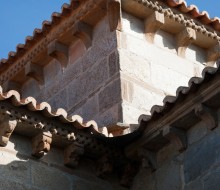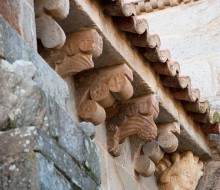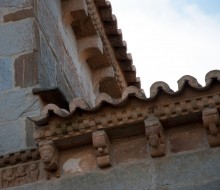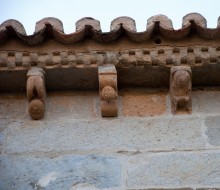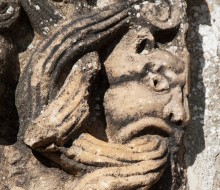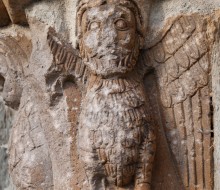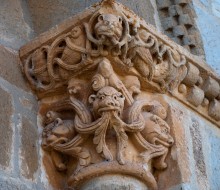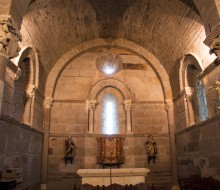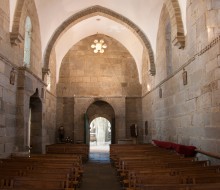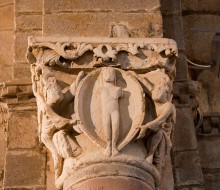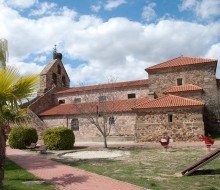Monastery of Santa Marta
Santa Marta de Tera
Monastery of Santa Marta
Santa Marta de Tera10th century
In 1996 it was discovered that in the church a magical phenomenon occurs: every year, during vernal and autumnal equinox, at 8 (solar time), the so-called capital of the saved soul is illuminated by sunlight coming in through the oculus in the head part gable.
Only the ancient Romanesque church has been preserved in the monastery. It has a Latin-cross plan of 27.50 by 16.50 and 6.18 meters wide for the nave and aisles, and a straight head part with 3 entries: the main is facing south, other facing the north perhaps was designed to access a cloister, and the very recent western pastiche at its foot.
In this church can be found many of the features of the Romanesque style: a beautiful head part layout, dome and transept, the wise placement of horizontal imposts, balanced small columns and vertical supports for arches, all of them with windows, which are blind in some cases and have window shades, and the slim cornices outlines and eaves with plain, vegetable, and figurative motifs in corbels. They are especially suggestive in the honey-colored apse roof.
The checkered molding is lavished everywhere inside and outside the temple, outlining imposts, cymas, eaves and window shades. This kind of checkered molding is called “jaqués” in Spanish, due to it is assumed that comes from the city of Jaca (Aragón).
The church has three doorways: the western is rough, the northern wing one which is nowadays used as access, is very plain and it just consist of a small gate. The most interesting is certainly the southern one, which was traditionally the most important access to enter this church till a graveyard installation, in the mid-19th century, that still surrounds it.
Capitals
This church has many capitals distributed in the southern doorway, in the transept and head part. It is in the chancel where can be seen the highest density of symbols, because it is the only place where it could be considered the existence of an iconographic series.
In the chancel area, in the main chapel, is shown the iconographic collection of the highest plastic quality and with the highest meaning of the church. Corinthian capitals abounds which show different skills, and are in different states of repair and forms: plain stalks, vegetable motifs with or without outgoing nerves, horn shaped motifs ended or not in balls. Worthy of special mention are the triumphal arch access and the capital where the nave starts.
The other capitals are figurative, and three of them are in the headwall: Sacrifice of Isaac, Saul and David with musicians and one with entwined forms. There are two in the northern wall: one with birds pecking back, with a central horn form between them and another triumphal arch with a nude image in a vesica piscis supported by two angels.
In the transept area, dominate Corinthian capitals. The capital of the rider and two prostrated human forms and the adulterous woman.
Outside the church are also different Corinthian capitals with animals and monsters motifs: The capital of the Epiphany, the capital with heads vomiting foliage ribbons, the capital with a crouching simian form...
The southern doorway consists of three semicircular arches. The central one is a convex molding and rosette intermediate strings and vegetal strip badly damaged, that rest on two columns with figured capitals, whose cyma extend into the jambs imposts.
Corbels
This church has a large set of corbels. These are rolls, plain on nacelle, some decorated with balls, others with holes.
In the nave, the northern corbels are plain with nacelle and some of them are rolls. There are 26 corbels in total. The southern corbels are plain with nacelle, some decorated with a ball, and others with lobes. There are 25 in total here.
In the apse, in the gable, they are plain and roll decorated. They have “crochets”: a man who carries a barrel on his shoulders. There are 11. In the northern part they are rolls decorated with horn shapes, ended by pine cones. Only one is complete, there are two plain, which are probably new. There are 9 in total. In the southern part there are 9, which are all new.
There are 10 in the northern transept. They are plain, have rolls or are decorated with pine cones. There are too a contortionist, another human form with hood who seems to be showing his genitals, at the southern end a head... On the northern side corbels have plain lobes and have pine cones; there is a figurine with a barrel on his shoulders. There are 13 in total here. On the west side there are 10 corbels, roll modillions decorated with pine cones, balls, etc.
In the southern transept, on the east side there are 10 corbels. They are rolls with balls, pine cones, horn shape and a kind of barrel. On the southern side there are 13. They are the richest in decoration of the whole church. They are roll with pine cones, balls, “crochets”, one with a protome of pork or of a wild boar, another naked figure showing the phallus and a broken contortionist.
In the dome, all are plain, and have nacelles, but one lobe on the western side has two figured with animal protomes in the corners.
The three apostles
They are different figures with different significance.
The sculpture of Jude can be seen in the northern transept shutter. It has a broken head but is more complete to the feet part.
In the southern doorway are the other two sculptures. The right one wears, as Jude, timeless clothing of an apostle and it is believed to be San Juan. The left one is the most famous and is Santiago pilgrim. His has a little fierce expression, bulging eyes, broken nose, open mouth that shows teeth and a schematic treatment of the long haired beard and hair which contrasts to his appearance, unlike the other apostles of the church.
This Santiago from Santa Marta has become famous for his Jacobean attributes: staff, the shoulder bag with carved holes as a rosary. Its flap grooms is decorated with a scallop shell.
GET DIRECTIONS
ROUTES
OPENING HOURS AND VISITS
From April to September:
- From Tuesday to Sunday: from 10:00 to 13:00 and from 17:00 to 20:00.
- Closed on Mondays.
From October to December:
- From Tuesday to Sunday: from 10:00 to 14:00 and from 16:30 to 18:30.
- Closed on Mondays.
Available guided tours.
GENERAL INTEREST SERVICES
Tourist office:
- Benavente: Located at 1, Mayor bajo Square. Tel. +34 980 63 42 11
Civil Guard (police with responsibilities outside towns):
- Benavente: Tel. +34 980 631 322
- Camarzana de Tera: Tel. +34 980 649 008
- Castroverde de Campos: Tel. +34 980 588 110
- Tábara: Tel. +34 980 590 020
- Villalpando: Tel. +34 980 660 019
- Manganeses de la Lampreana: Tel. +34 980 501 020
Emergency telephone numbers: 112
- Camarzana de Tera medical center: Tel. +34 980 64 90 38
- Tábara medical center: Tel. +34 980 59 02 18
- Villalpando medical center: Tel. +34 980 66 04 77
- Benavente sur medical center: Tel. +34 980 63 03 29
- Benavente Norte medical center: Tel. +34 980 63 53 61
Bus station:
Benavente: Tel. +34 980 632 711
Train station:
Benavente: Tel. +34 905 551 844
Taxis:
- Benavente: Tels. +34 980 637 171 / +34 980 649 059 / +34 696 669 470 / +34 609 204 373
Civil defence:
- Benavente: Tel. +34 980 637 475
